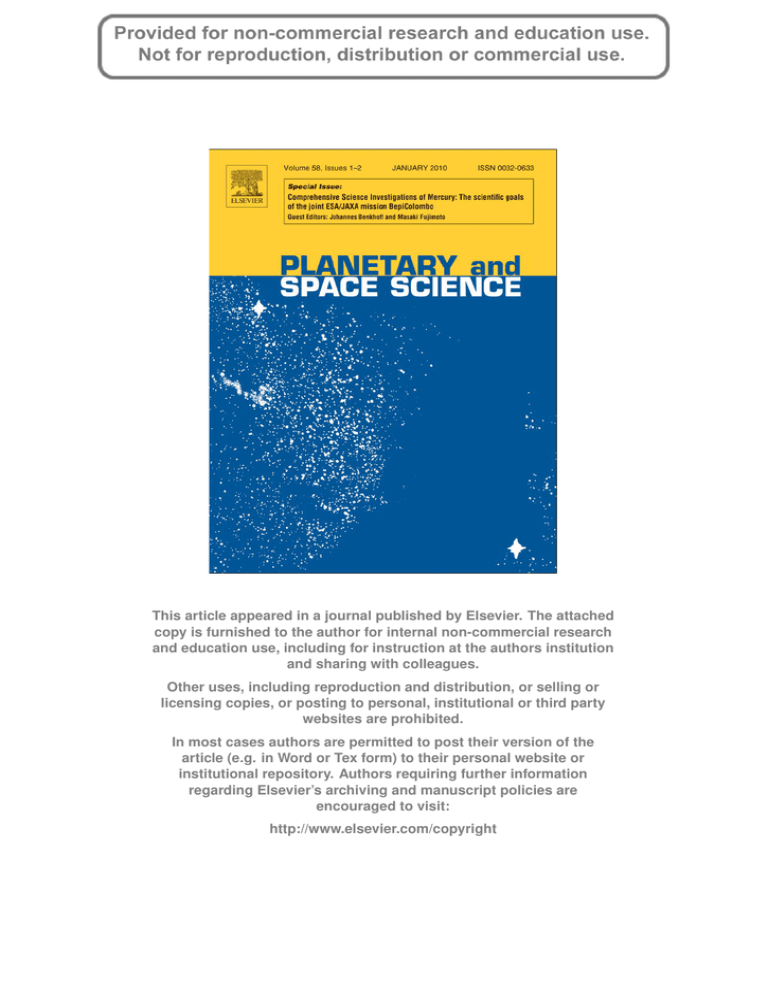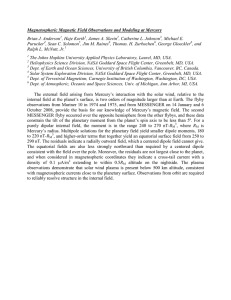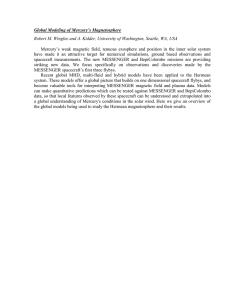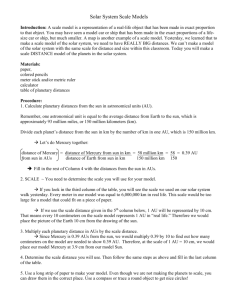
This article appeared in a journal published by Elsevier. The attached
copy is furnished to the author for internal non-commercial research
and education use, including for instruction at the authors institution
and sharing with colleagues.
Other uses, including reproduction and distribution, or selling or
licensing copies, or posting to personal, institutional or third party
websites are prohibited.
In most cases authors are permitted to post their version of the
article (e.g. in Word or Tex form) to their personal website or
institutional repository. Authors requiring further information
regarding Elsevier’s archiving and manuscript policies are
encouraged to visit:
http://www.elsevier.com/copyright
Author's personal copy
ARTICLE IN PRESS
Planetary and Space Science 58 (2010) 1
Contents lists available at ScienceDirect
Planetary and Space Science
journal homepage: www.elsevier.com/locate/pss
Foreword
Foreword to the Special Issue of Planetary and Space Science on the
BepiColombo Mission to Mercury
Mercury is a planet of superlatives and paradoxes. Among Solar
System planets, it is the closest to the Sun, displays the highest
diurnal variation in surface temperature, and has the most
transient atmosphere, yet it may harbor long-lived water ice on
the floors of its polar craters. It is the only Solar System body in a
3:2 spin–orbit resonance, so that its solar day lasts for 2 Mercury
years. The smallest planet in our Solar System, Mercury also has
the highest uncompressed density. Its surface is the oldest among
the family of terrestrial planets, yet it is the smallest planet with a
modern global magnetic field, and it has the most Earth-like
magnetosphere.
Despite Mercury’s intriguing mix of characteristics, as recently
as 2 years ago the planet had been visited by only a single
spacecraft. Mariner 10 flew by Mercury three times in 1974–1975,
imaged about 45% of the surface, discovered the planet’s internal
magnetic field, documented three species in Mercury’s tenuous
atmosphere, and sampled the planet’s small magnetosphere.
Those early Mariner 10 observations, and subsequent groundbased astronomical discoveries, raised a number of basic questions about Mercury that could not be addressed without further
spacecraft exploration. In the last decade, three space agencies
responded to this scientific imperative. In 1999, the US National
Aeronautics and Space Agency (NASA) selected the MErcury
Surface, Space ENvironment, GEochemistry, and Ranging (MESSENGER) spacecraft to be the first probe to orbit the innermost
planet. Launched in August 2004, MESSENGER flew by Mercury
three times in 2008 and 2009 en route to a scheduled insertion
into orbit about Mercury in March 2011. In 2000, the European
Space Agency (ESA) announced the selection of the dual-orbiter
BepiColombo mission and engaged the partnership of the
Japanese Institute of Space and Astronautical Science (now the
Japan Aerospace Exploration Agency, or JAXA) to develop one of
the two spacecraft and much of its payload.
Named for Giuseppe Colombo, the Italian mathematician who
in 1965 offered one of the first explanations for why Mercury is in
its peculiar spin–orbit resonance and later pointed out to NASA
how a modification to the trajectory of Mariner 10 would permit
multiple flybys of Mercury rather than only the one originally
planned, the BepiColombo mission is the most ambitious effort
yet attempted in the exploration of Mercury. Two spacecraft, ESA’s
Mercury Planetary Orbiter (MPO) and JAXA’s Mercury Magnetospheric Orbiter (MMO), are to be launched together in July 2014
on an Ariane 5. Through a combination of solar electric propulsion
and inner-planet flybys, the two probes will be delivered in 2020
into coplanar polar orbits about Mercury, where the MPO will
study the planet in unprecedented detail and the MMO will
conduct a thorough characterization of Mercury’s dynamic
magnetosphere and its strong interaction with the interplanetary
magnetic field and solar wind plasma.
This special issue of Planetary and Space Science is the first
detailed description of the BepiColombo mission in the scientific
literature. Following a mission overview by BepiColombo Project
Scientist Johannes Benkhoff and his colleagues, there are papers
on each of 15 instruments and instrument suites in the mission’s
scientific payload, including 10 on MPO and five on MMO.
Complementing those technical descriptions are three papers
summarizing the state of scientific knowledge of Mercury at this
stage in BepiColombo development and one paper on mission
science operations.
A bit more than a decade from now, at the completion of the
BepiColombo mission, our understanding of Mercury will at long
last rival that of its larger sister planets, and we will have gained
critical new insight into how the inner Solar System formed and
evolved.
Sean C. Solomon n
Department of Terrestrial Magnetism, Carnegie Institution of
Washington, 5241 Broad Branch Road, N.W., Washington, DC 20015,
USA
E-mail address: scs@dtm.ciw.edu
Available online 21 October 2009
n
0032-0633/$ - see front matter & 2009 Elsevier Ltd. All rights reserved.
doi:10.1016/j.pss.2009.10.003
Tel.: + 1 202 478 8850; fax: +1 202 478 8821.






